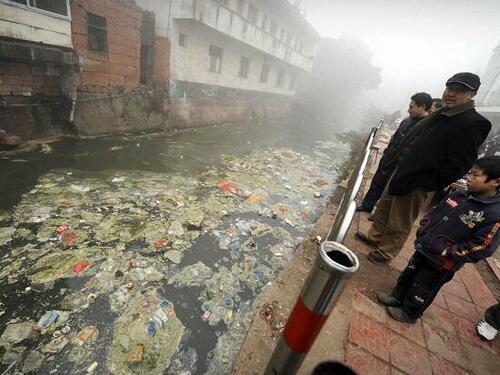
Authored by Charles Hugh Smith via OfTwoMinds blog,
We need a new iteration of economics that advances beyond the obsolete, misleading statistical measurements of bygone eras.
Let's focus on a largely forgotten history, one within living memory of everyone born in the 1950s, a history of signal importance to our understanding of the forces that will dominate the next decade.
The 1970s in mainstream history is: exaggerated fashions, disco, Watergate, the end of the Vietnam War, the gas crisis, the presidency of Jimmy Carter and stagflation.
Stagflation--inflation plus stagnant growth--is once again in the news, and there are numerous articles comparing the present to the 1970s.
What's astonishing is none of these comparisons (at least those I've seen) even mention the most economically consequential dynamic of the 1970s: the institutionalization of environmental standards that forced the clean-up of America's pervasive industrial pollution and the re-engineering of the industrial base.
In today's money, cleaning up the sources of air, water and soil pollution cost trillions of dollars, an investment that didn't generate profits or productivity as measured in financial terms.
The eventual gains were enormous, but our conventional financial measures of growth--profits and productivity--do not measure improvements in air and water quality or advances in public health due to the sharp reduction in pollution.
Well-being isn't measured, so it isn't recognized.
These costs were not fully accounted or properly attributed to reversing decades of industrial pollution and rebuilding America's aging, obsolete, inefficient, highly polluting industrial base.
Instead, the financial burdens of this sustained investment in cleaning up the nation's environment were written off as "stagflation," a catch-all word that lacks any explanatory insight.
The gains were not strictly financial, and so they weren't measured. Since they weren't measured, both the costs and gains were overlooked and then forgotten.
It's hard to imagine how poor the air and water quality was by 1970. (The U.S. Environmental Protection Agency (EPA) was established on December 2, 1970.)
Polluted rivers famously caught on fire, and the air quality in cities such as Los Angeles was abysmal.
I recently watched a scene from an early 1970s Columbo episode filmed in an LA high-rise and was struck by the thick layer of toxic smog blanketing the city.
Appliances and vehicles were terribly inefficient because nobody cared about efficiency when energy was dirt-cheap.
U.S. factories were a generation behind global competitors such as Germany and Japan, whose industrial base had been rebuilt to modern standards after being devastated in World War II.
Many U.S. plants were drafty, uninsulated and filled with equipment from a previous era.
Changing all this required trillions of dollars of investment and many years--costs which did not generate profits or immediate productivity gains.
It wasn't until the 1980s that the payoff from this stupendous effort became visible and measurable. Although it's largely been forgotten, we're still collecting "dividends" on the investments made in the "stagflationary" 1970s.
Since we don't measure "growth" in well-being, the gains from the 1970s were uncounted. The gains in efficiency and quality were also under-counted.
Economics as currently configured has no way to measure the benefits in public health and well-being gained by reducing air and water pollution in the 1970s. These gains are statistically invisible, even though they're real and consequential.
(Pollution remains an issue, of course; "forever chemicals," Super-Fund sites, etc. still require regulations, enforcement and sustained spending.)
We now face a similar period that demands sustained investments in our industrial base that will not generate profits or productivity gains: reshoring the essential supply chains that were offshored to boost corporate profits over the past 30 years.
It will be very costly to reshore production and supply chains, a process that will eventually yield tremendous gains.
But they will be gains that conventional financial measures will completely miss--gains in national security, resilience, efficiency and stability.
Conventional economists and pundits have overlooked the primary cause of "stagflation" in the 1970s, and they'll also miss the role of reshoring in the current era of "stagflation."
Not only do we only manage what we measure, we also only see and understand what we measure. If it's not measured in conventional terms, it vanishes from the stories we tell ourselves, i.e. history.
As I explain in my book Global Crisis, National Renewal, reshoring and rebuilding a super-efficient industrial base will separate the world's nations into the few which not just survive but thrive and the rest that decay and collapse.
Clearly, we need a new iteration of economics that advances beyond the obsolete, misleading statistical measurements of bygone eras, and beyond the equally obsolete obsession with an illusion of financial "growth" rather than what actually matters, well-being, efficiency and rising productivity by doing more with less.
In the industrializing world, the costs of cleaning up industrial pollution have yet to be paid in full. The costs will be paid either in cash or in diminished public health and higher health expenditures.
* * *
My new book is now available at a 10% discount ($8.95 ebook, $18 print): Self-Reliance in the 21st Century. Read the first chapter for free (PDF)
Authored by Charles Hugh Smith via OfTwoMinds blog,
We need a new iteration of economics that advances beyond the obsolete, misleading statistical measurements of bygone eras.
Let’s focus on a largely forgotten history, one within living memory of everyone born in the 1950s, a history of signal importance to our understanding of the forces that will dominate the next decade.
The 1970s in mainstream history is: exaggerated fashions, disco, Watergate, the end of the Vietnam War, the gas crisis, the presidency of Jimmy Carter and stagflation.
Stagflation–inflation plus stagnant growth–is once again in the news, and there are numerous articles comparing the present to the 1970s.
What’s astonishing is none of these comparisons (at least those I’ve seen) even mention the most economically consequential dynamic of the 1970s: the institutionalization of environmental standards that forced the clean-up of America’s pervasive industrial pollution and the re-engineering of the industrial base.
In today’s money, cleaning up the sources of air, water and soil pollution cost trillions of dollars, an investment that didn’t generate profits or productivity as measured in financial terms.
The eventual gains were enormous, but our conventional financial measures of growth–profits and productivity–do not measure improvements in air and water quality or advances in public health due to the sharp reduction in pollution.
Well-being isn’t measured, so it isn’t recognized.
These costs were not fully accounted or properly attributed to reversing decades of industrial pollution and rebuilding America’s aging, obsolete, inefficient, highly polluting industrial base.
Instead, the financial burdens of this sustained investment in cleaning up the nation’s environment were written off as “stagflation,” a catch-all word that lacks any explanatory insight.
The gains were not strictly financial, and so they weren’t measured. Since they weren’t measured, both the costs and gains were overlooked and then forgotten.
It’s hard to imagine how poor the air and water quality was by 1970. (The U.S. Environmental Protection Agency (EPA) was established on December 2, 1970.)
Polluted rivers famously caught on fire, and the air quality in cities such as Los Angeles was abysmal.
I recently watched a scene from an early 1970s Columbo episode filmed in an LA high-rise and was struck by the thick layer of toxic smog blanketing the city.
Appliances and vehicles were terribly inefficient because nobody cared about efficiency when energy was dirt-cheap.
U.S. factories were a generation behind global competitors such as Germany and Japan, whose industrial base had been rebuilt to modern standards after being devastated in World War II.
Many U.S. plants were drafty, uninsulated and filled with equipment from a previous era.
Changing all this required trillions of dollars of investment and many years–costs which did not generate profits or immediate productivity gains.
It wasn’t until the 1980s that the payoff from this stupendous effort became visible and measurable. Although it’s largely been forgotten, we’re still collecting “dividends” on the investments made in the “stagflationary” 1970s.
Since we don’t measure “growth” in well-being, the gains from the 1970s were uncounted. The gains in efficiency and quality were also under-counted.
Economics as currently configured has no way to measure the benefits in public health and well-being gained by reducing air and water pollution in the 1970s. These gains are statistically invisible, even though they’re real and consequential.
(Pollution remains an issue, of course; “forever chemicals,” Super-Fund sites, etc. still require regulations, enforcement and sustained spending.)
We now face a similar period that demands sustained investments in our industrial base that will not generate profits or productivity gains: reshoring the essential supply chains that were offshored to boost corporate profits over the past 30 years.
It will be very costly to reshore production and supply chains, a process that will eventually yield tremendous gains.
But they will be gains that conventional financial measures will completely miss–gains in national security, resilience, efficiency and stability.
Conventional economists and pundits have overlooked the primary cause of “stagflation” in the 1970s, and they’ll also miss the role of reshoring in the current era of “stagflation.”
Not only do we only manage what we measure, we also only see and understand what we measure. If it’s not measured in conventional terms, it vanishes from the stories we tell ourselves, i.e. history.
As I explain in my book Global Crisis, National Renewal, reshoring and rebuilding a super-efficient industrial base will separate the world’s nations into the few which not just survive but thrive and the rest that decay and collapse.
Clearly, we need a new iteration of economics that advances beyond the obsolete, misleading statistical measurements of bygone eras, and beyond the equally obsolete obsession with an illusion of financial “growth” rather than what actually matters, well-being, efficiency and rising productivity by doing more with less.
In the industrializing world, the costs of cleaning up industrial pollution have yet to be paid in full. The costs will be paid either in cash or in diminished public health and higher health expenditures.
* * *
My new book is now available at a 10% discount ($8.95 ebook, $18 print): Self-Reliance in the 21st Century. Read the first chapter for free (PDF)
Loading…





